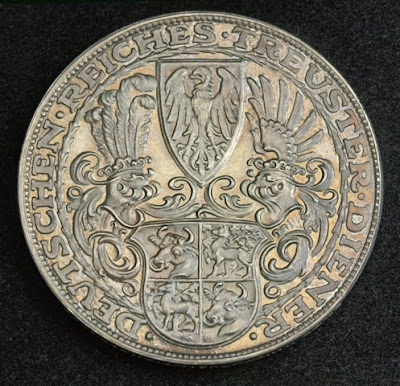 |
| German 5 Reichsmark silver coin |
 |
| German 5 Reichsmark silver coin President Hindenburg 80th anniversary |
Obverse: Head of Paul von Hindenburg right, mintmark (D) in left field.
Reverse: Large coat of arms featuring helmets, squared shield and prussian eagle shield above.
Large medallic thaler-like 5 Reichsmark silver crown, designed by one of the most gifted german medallists Karl Goetz, during 1927. This commemorates the 80th anniversary of Paul von Hindenburg and features a large thaler-like coat of arms on its reverse.
Mint Pleace: Munnich (D)
Reference: Kienast 386. KM-M1.
Denomination: 5 Reichsmarks, Medallic Issue "Hindenburg Anniversary".
Material: Silver (.900)
Weight: 25.03 gm
Diameter: 36 mm
German Coins, German coinage, German silver coins, German States Coins, Coins of Germany, German Gold Coins, German commemorative coins, German Imperial Coins, Numismatic Collection, Coins of the German Empire, Coins of Germany best silver coins for investment, silver coins, German East Africa coins, old coins, coin collecting, rare coins, world coins, foreign coins, heritage coins, silver ira investment, silver bullion coins, silver coin collection investors, investment coins, antique coins, Unique Silver Coins, collectible coins, Münzen Deutschland, silbermünzen, Münzen aus Deutschland, Münzen Deutsches Kaiserreich.
Paul von Hindenburg
Paul Ludwig Hans Anton von Beneckendorff und von Hindenburg (known universally as Paul von Hindenburg (2 October 1847 – 2 August 1934) was a Prussian-German field marshal, statesman, and politician, and served as the second President of Germany from 1925 to 1934.
Hindenburg enjoyed a long career in the Prussian Army, retiring in 1911. He was recalled at the outbreak of World War I, and first came to national attention, at the age of 66, as the victor of the decisive Battle of Tannenberg in August 1914. As Germany's Chief of the General Staff from 1916 (having replaced Erich von Falkenhayn on August 29), he and his deputy, Erich Ludendorff, rose in the German public's esteem until Hindenburg gradually gained more influence in Germany than the Kaiser himself. Together with Ludendorff they pushed forward the idea of Lebensraum which after the war would be adopted by Hitler's Nazi party. Hindenburg retired again in 1919, but returned to public life in 1925 to be elected as the second President of Germany.
Hindenburg, as German President, appointed Nazi Party leader Adolf Hitler as Chancellor of Germany. Hindenburg personally despised Hitler, condescendingly referring to Hitler as that "Bohemian corporal" (in German böhmischen Gefreiten), confusing (deliberately or not) Hitler's birthplace of Braunau, Austria, with Braunau in Bohemia. Hitler repeatedly and forcefully pressured Hindenburg to appoint him as Chancellor; Hindenburg repeatedly refused Hitler's demand.[2] Though 84 years old and in poor health, Hindenburg was persuaded to run for reelection in 1932, as he was considered the only candidate who could defeat Hitler. Hindenburg was reelected in a runoff. Although he was opposing Hitler, the deteriorating political stability of the Weimar Republic let him play an important role in the Nazi Party's rise to power. He dissolved the parliament twice in 1932 and finally appointed Hitler Chancellor in January 1933. In February, he issued the Reichstag Fire Decree, which suspended various civil liberties, and in March he signed the Enabling Act, which gave Hitler's administration legislative powers. Hindenburg died the following year, after which Hitler declared the office of President vacant and, as "Führer und Reichskanzler", made himself head of state.
The famed zeppelin Hindenburg that was destroyed by fire in 1937 was named in his honor, as was the Hindenburgdamm, a causeway joining the island of Sylt to mainland Schleswig-Holstein that was built during his time in office. The previously German Upper Silesian town of Zabrze (German: Hindenburg O.S.) was also renamed after him in 1915. SMS Hindenburg, a battlecruiser commissioned in the Imperial German Navy in 1917 and the last capital ship to enter service in the Imperial Navy, was also named after him.